Mitella stauropetala
Erythea 7: 161. 1899 ,.
Plants not stoloniferous. Flowering stems 10–55 cm. Leaves: petiole 2–15 cm, short stipitate-glandular and long stipitate-glandular, longer hairs retrorse or, sometimes, spreading, white, tan, or brown; blade cordate or reniform, shorter than or sometimes ± as long as wide, (1.5–)2.5–10 × 2–8(–12) cm, margins 5- or 7-lobed, singly or doubly crenate, uniformly ciliate, apex of terminal lobe rounded to obtuse, surfaces glabrous or short stipitate-glandular and sparsely long stipitate-glandular; cauline leaves absent. Inflorescences 1–3(–6), closely 10–45-flowered, 1 flower per node, strongly secund, 10–55 cm, short stipitate-glandular and sparsely long stipitate-glandular proximally and distally. Pedicels 0.5–1.5 mm, short stipitate-glandular. Flowers: hypanthium turbinate-campanulate, 1.4–2.7 × 1.5–2.5(–3) mm; sepals erect or with tips spreading, greenish white to white, sometimes purple-tinged, oblong, oblong-obovate, or widely ovate, 1–2.2 × 0.7–1.2 mm; petals white, sometimes purple-tinged, 3-lobed or, sometimes, unlobed, 1.5–4 mm, lobes linear to lanceolate, lateral lobes ascending or spreading; stamens 5, opposite sepals; filaments white, 0.1–0.2 mm; anthers 0.3–0.5 × 0.2–0.3 mm; ovary ca. 2/3–3/4 inferior; styles divergent, flattened, 0.1–0.2 mm; stigmas unlobed. Seeds dark reddish brown to blackish, 0.8–1.2 mm, pitted. 2n = 14.
Phenology: Flowering May–Jul.
Habitat: Open to dense woods, seasonally moist, springy sites
Elevation: 700-3000 m
Distribution

Colo., Idaho, Mont., Oreg., Utah, Wash., Wyo.
Discussion
Two varieties of Mitella stauropetala have been recognized. Plants from Oregon and Washington have been referred to var. stauropetala, characterized by hypanthium plus sepals often over 3 mm and petal blades with linear lobes. In northern Colorado, southeastern Idaho, eastern Utah, and Wyoming, var. stauropetala is replaced by var. stenopetala, with hypanthium plus sepals rarely over 3 mm and petal blades less deeply trifid (sometimes entire) and with broader lateral lobes. Variety stenopetala is morphologically similar in many respects to M. trifida. Mitella trifida and M. stauropetala require study to determine if plants referred to var. stenopetala are the result of hybridization or integradation between the two species.
D. E. Soltis and P. S. Soltis (1986) found morphologic and allozymic evidence of fertile intergeneric hybrids between Mitella stauropetala and Conimitella williamsii in Wyoming. Data from cpDNA analysis suggest that C. williamsii is derived from within the M. diversifolia–M. stauropetala–M. trifida alliance (D. E. Soltis et al. 1990).
Selected References
None.
